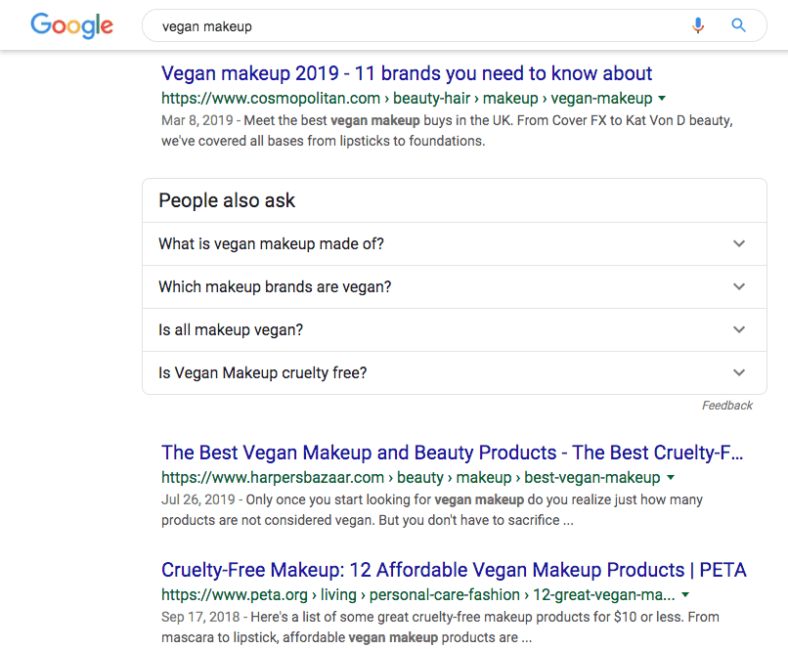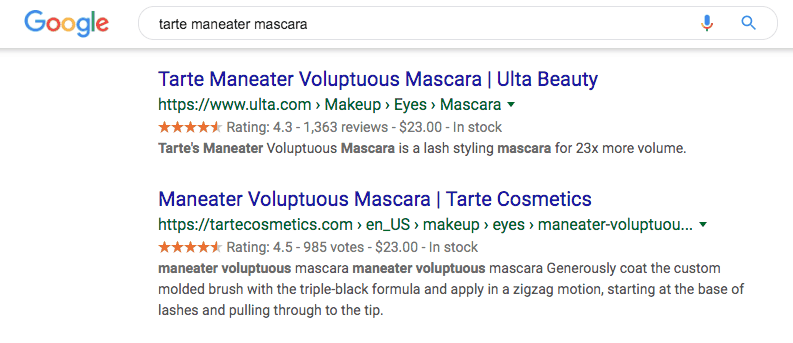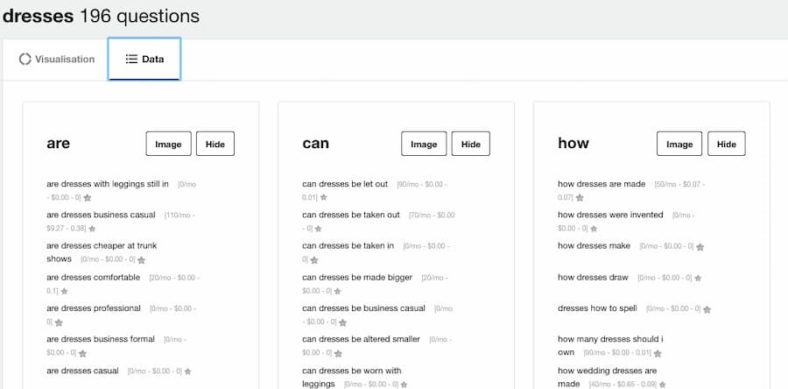Editor’s note: This post was originally published in 2019 and has since been updated to ensure accuracy and to adhere to modern best practices.
Is it worth targeting long tail keywords for eCommerce websites? Contrary to what search volume suggests, our answer is an unequivocal “yes.”
eCommerce marketers tend to chase keywords with a high search volume. These higher volume keywords can get good, sometimes great, results — if you can beat the competition. Often, however, you end up running out of high volume keywords to target that you can actually rank for.
Trying to outrank your competitors can get tiring quickly. So, why not change the game to one you can win by going after less competitive keywords that people are searching for?
That’s right: Low search volume keywords often do get clicks — and deserve a spot in your SEO strategy.
Our eCommerce clients regularly bring in traffic and revenue from long tail keywords. If you’re wondering about the effectiveness of long tail keywords for your eCommerce website, you’ve come to the right place.
Find out whether your company can cash in on these oft-overlooked keywords today, by learning:
- What long tail keywords are (and why so many people ignore them)
- Why search intent influences SEO success
- How to find long tail keywords for your products and website
- And how to implement them for the best conversion results
Want assistance targeting the best long tail keywords for your eCommerce business? Request a free proposal to get a custom strategy that will increase your organic traffic and sales from search engines.
What do long tail keywords look like for eCommerce brands?
Long tail keywords typically contain three to four words (and sometimes more). They’re typically very specific to a product, such as “Honeywell Wifi Thermostat RTH6580WF.” They might also be a question the customer has, such as “control thermostat with smartphone.”
Short tail keywords, as you might guess, are one word, sometimes two — such as, “thermostat” or “wifi thermostats.”

Long tail keywords are so named because they make up the long tail end of traffic (there are lots of them, and they don’t get as many searches). But, because long tail keywords for eCommerce are usually less broad and more targeted to consumers at the bottom of the marketing and sales funnel, they convert well — often even better than short tail keywords (also known as head terms).
Take a look at one of our clients in the moving company niche. They’re getting clicks on “0” volume keywords, including 1,724 clicks on an eleven-word keyword phrase:

Why Long Tail Keywords for eCommerce are Often Ignored
Marketers with less experience will overlook or write off long tail keywords. They see the low or non-existent estimated monthly search traffic volume as a sign that it won’t bring in traffic.
This is a huge mistake.
Somebody searching for “wifi thermostat” may be shopping around and comparing models, while someone searching for a specific brand or model is way closer to making a buying decision.
It’s all about the search intent behind the keyword phrase.
How Search Intent Influences Conversions
Not every low volume, long tail keyword for eCommerce will result in increased conversions. In order for a long tail (or short tail!) search query to convert, it’s important to look at intent.
Many agencies managing SEO for eCommerce brands will pick and target keywords without considering what led a searcher to type in that phrase. If an SEO marketer doesn’t understand what a user is actually looking for, they certainly won’t be able to create content that compels and converts.
Here’s a simple way to check search intent for a keyword: Type the keyword into Google, and look at the first page of results. You’ll see the results that people are actually clicking on, because they match the user’s search intent.
For example, you might think that someone with the intent to buy would type a keyword like “vegan makeup.” However, when you search this phrase, informational articles from third parties like magazines and PETA are what come up — not eCommerce stores with individual products.

Google’s algorithm is always learning from what users type in and what they engage with. The results displayed on the first page for a given search are generally a good indicator of what people want to get when they type in that keyword or phrase. So, for a short tail phrase like “vegan makeup,” people are researching what’s out there, but not looking to buy any makeup just yet.
Long tail keywords, on the other hand, do tend to have high intent — especially if they contain a branded phrase. For example, “tarte maneater mascara” brings up available stores where you can buy the brand’s product:

Long tail keywords are important for ranking product and category pages for the same reason: Those pages are near impossible to rank for competitive short tail terms.
The bottom line: You can have less competition, a lower cost, and a better conversion rate when you keep search intent in mind.
How to Identify Long Tail Keywords for Your Business
Finding long tail keywords that will convert involves more than just looking at phrase length and search volume. We follow a few important steps to identify keywords that not only give the best chance of increased organic traffic, but also have the highest indication of converting.
Step 1: Use Google Search Console.
Start by looking at the eCommerce company’s site in Google Search Console. Look at which terms are ranking for that site, and sort them by clicks to find the most relevant ones. If you see any keywords without volume getting clicks (like our moving company client above), you’ve found some potential.
After you find long tail keywords in GSC, consider optimizing existing pages for them or creating new content to target those searches.
Step 2: Do Additional Long Tail Keyword Research.
Follow up your initial research with a long tail keywords tool like Ahrefs or Semrush. You can confirm any terms you identified in the previous step, as well as find additional keywords to target.
We sort by search volume, and then start plugging keywords into a spreadsheet to match them up to the page on the client’s site that ranks for those terms.
Step 3: Check Search Intent in SERPs.
Remember the importance of search intent? Time for a little hands-on work.
We recommend checking each term manually in search results to make sure it matches the user intent. This saves us from optimizing a product page for a keyword when people are looking for blog posts, and vice versa.
Step 4: Implement Continuous Keyword Monitoring.
We also recommend setting up keyword alerts in Ahrefs to monitor for new long tail terms we should incorporate.
Each week, Ahrefs sends us an email of the keywords our client’s site is ranking for that jumped into the top 20 (or 40–60) of results — and we can optimize further to get in the top 10 results.
Over time, a page will rank for additional long tail keywords as the research tool indexes it. If we think one of those keywords can convert well, we recommend our clients optimize for that phrase.
Other Ways to Find Long Tail Keywords
There are plenty of tutorials for finding keywords and implementing them (our eCommerce Copywriting Guide is an excellent primer). We won’t go in depth about those here; we’ll just list a few more options for your long tail keyword research.
Use Google’s Tools
Google Keyword Planner shows which long tail keywords have commercial value, but we typically find fewer of them. You’ll often find better results with Google tools that aren’t specifically designed for keyword research.


Google Suggested Search and “People Also Ask” are easy and quick ways to get additional long tail keyword ideas. Just start typing in your search phrase and look at the autocomplete options:
You can also type in your product keyword and view the questions people are asking. These are long tail keyword phrases you can optimize for — sometimes resulting in an article on your site answering a question in the “People Also Ask” box.
Google Ads Search Term Report shows you which ads were triggered by actual searches, including long tail keywords. Sometimes, a user will search a relevant long tail keyword you didn’t even think of — and your ad came up for it!
Use Keyword Research Tools
We’ve mentioned Ahrefs and Semrush above, but you can also use tools like Ubersuggest, Moz. All of them have extensive keyword databases that you can mine for your research.
Type in a short tail keyword, and gather long tail keywords from the related terms that these SEO tools show you. Even if you see less than 10 searches a month for a long tail phrase, you will get at least a couple of clicks from optimizing for it. Rank for enough of these phrases and you can get a significant amount of traffic.

Answer the Public is another good tool. Use it to search a short tail term and see a list of questions that people are asking about it in search engines:
Use Amazon
Amazon is a wealth of knowledge when it comes to finding long tail keywords for eCommerce.
If you’re listing products on Amazon, use their search term report to see which phrases people typed in to get to your product page. Then, you can add those keywords to your Amazon listing and the product page on your own website. Chances are, people are typing those same shopping-related phrases into Google.
Like Google, Amazon will give you suggested search suggestions when you start typing.

Pair your suggested searches in Google, Amazon, and elsewhere with a tool like Keywords Everywhere to see quick stats about the terms.
How to Use Long Tail Keywords to Increase Conversions
Now you know how to find long tail keywords for eCommerce. But, to make them work for your online business, you need to make the right pages relevant for them.
Here’s how:
- Evaluate the existing page and its opportunities. Once you choose a long tail keyword, take a closer look at the page you’re optimizing it for. Is it ranking for anything else? What products does it convert for? Tailor your optimization plan to that performance.
- Optimize the page. This includes the H1, meta title, meta tags, body copy, and images. If you’re also optimizing that for a short tail keyword, including a long tail keyword secondarily will help the page rank for both kinds of phrases.
- Add more content, if necessary. Depending on the page type, you might add more content to make it more relevant to the long tail keyword. We’ve found this to work better on product pages than category pages. Too much content on a category page pushes the product grid further down the page, and that added scrolling space can hurt conversions.
- Implement internal links. To further increase relevance for the long tail phrase, look for blog posts to internally link to from the product or category page, and use the long tail keyword as the anchor text.
Remember: Keywords aren’t just for SEO. If you’re running PPC ads for eCommerce, use the long tail phrases for that, too! Google ads are there so that you can pay to beat the organic rankings. We recommend you target longtails in both SEO and PPC.
Don’t have an existing page that ranks?
If we aren’t adding content to an existing page, we’ll create a new page or update one to optimize it. When updating content, we look for pages that performed well in the past (based on their former rankings or sessions from visitors), but have since dropped off.
We’ll then reoptimize the page by:
- Sprinkling long tail keywords into the copy
- Adding new sections to the page using the long tail term as an “H2”
- Refreshing the page by adding more useful content for visitors
Here’s an example: We have a client with an eCommerce store in the freeze dried food niche. In our research, we discovered that their product page for freeze-dried ice cream was ranking for adjacent phrases like “space ice cream” or “astronaut ice cream.”
Rather than simply sprinkle those words onto the product page, we created new “H2” headings to really target those long tail keywords. As a result, their rankings for “space ice cream” and “astronaut ice cream” increased.
Now, they’re targeting and ranking for three separate terms that their customers used in Google when looking for freeze-dried ice cream — rather than just the one.
Conclusion
Business growth doesn’t happen overnight. It’s the result of small pieces of value adding up over time. The same idea applies to keyword targeting.
Remember that inbound marketing for eCommerce relies on the pain points (or simply the needs) of your customers. Take an inventory of all the products, questions, and objections that potential customers have about what you sell. Are there certain questions they have to ask before they buy a product? Is there something else in their head that is preventing them from making a purchase?
Take all of those answers, and put them on your website. Because you’ve put the content there, your customers are more likely to:
- Find the right product
- Get the answer to their questions
- Trust your store to make the purchase
This might sound simple, but it’s the core of why SEO works, and it’s why long tail keywords lead to conversions.
Ranking for more long tail keywords than your competition is a tried and true strategy for increasing the value of your eCommerce store. The extra traffic from each longtail keyword you rank for can really add up, so don’t delay. Start implementing these tactics into your SEO strategy today.
Need help to get it done? We do this type of work for clients day-in and day-out. If you want to increase your traffic and sales with our winning SEO strategies, please contact us today.











Amazing Article!
Great tips on choosing keywords for eCommerce.
Thanks for sharing.
Hi Alex,
Thanks for interesting article!
I just was wondering what do you mean by Look at the client’s site AND their competitors in GSC? I get the client part, but how do utilize GSC in order to find competitor data or am I just missing something?
Hi Karoliina, Oops! That was a mistake. You’re right, you can’t look at competitors in GSC. I’ve updated the article. Sorry for the confusion!